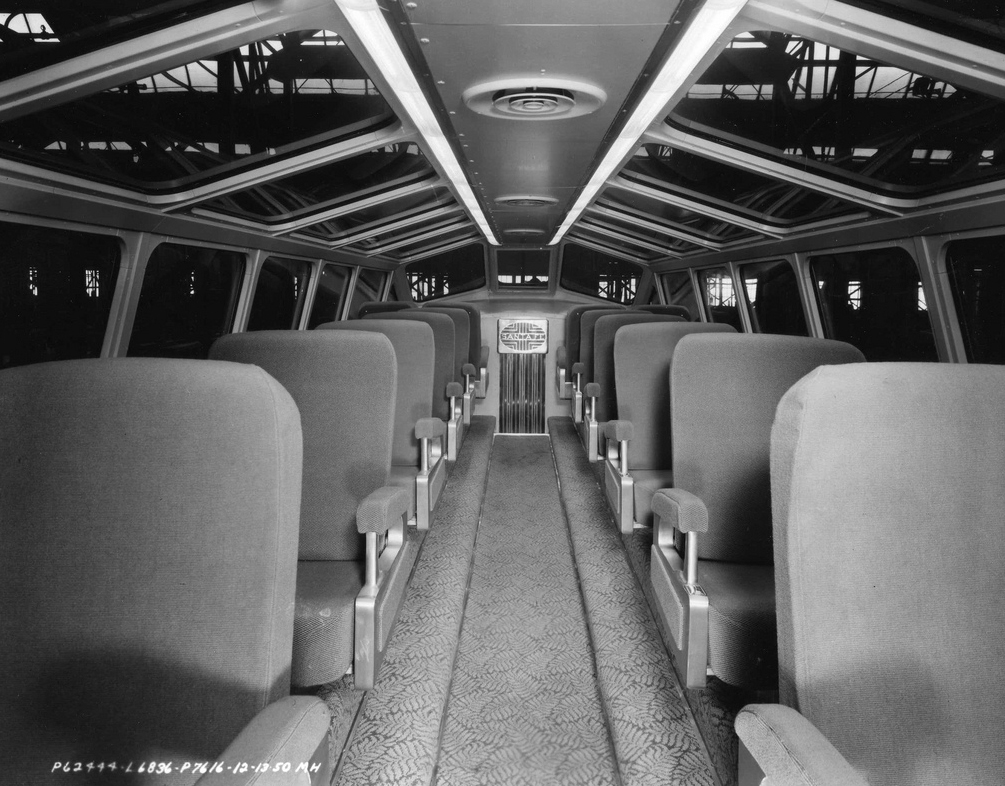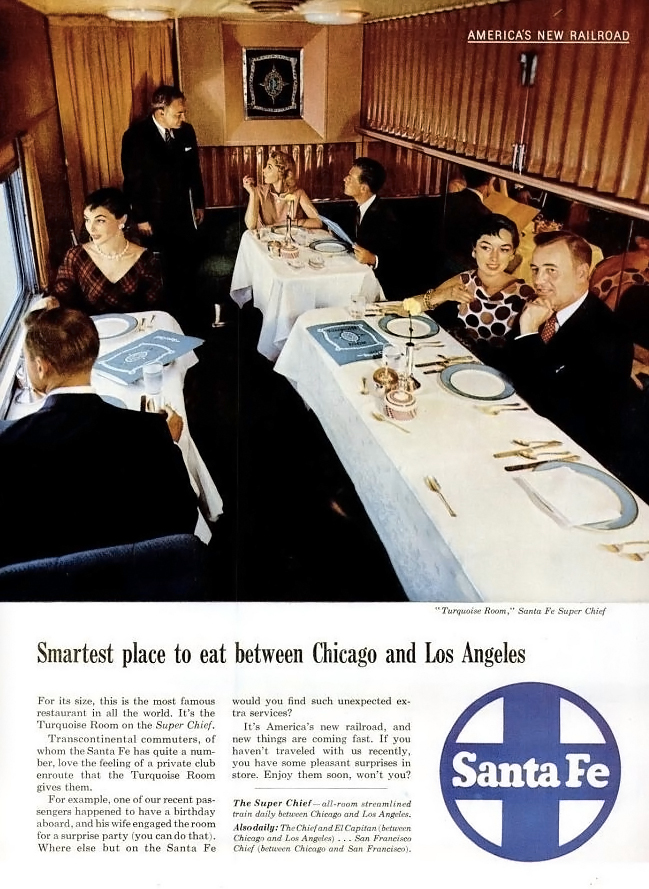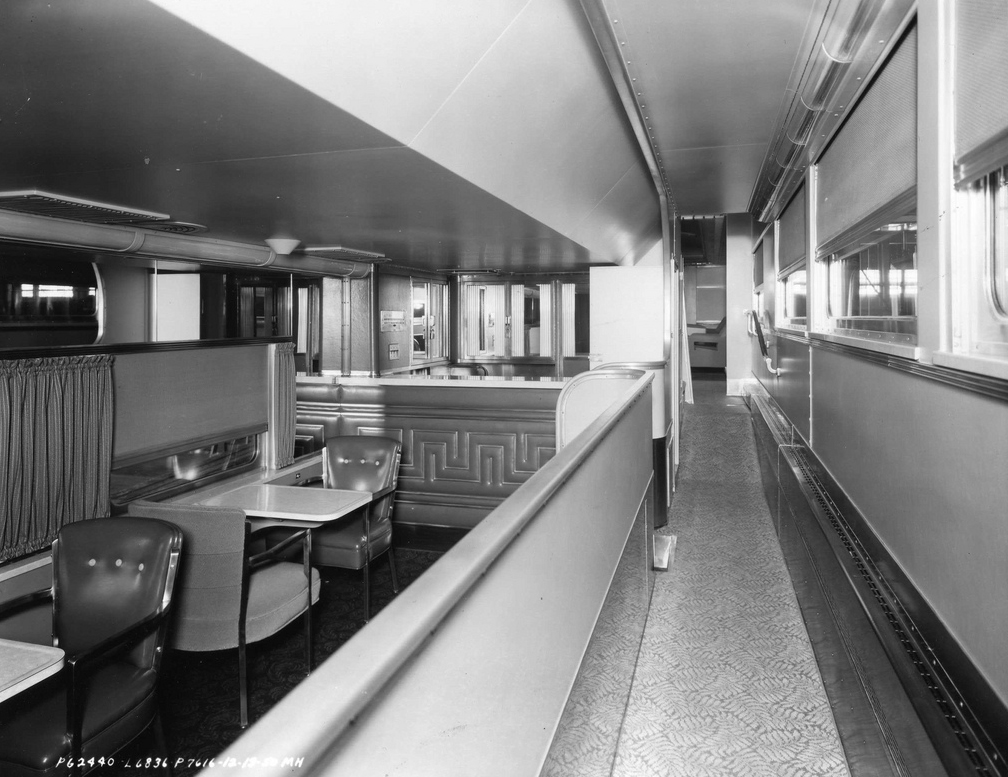"Pleasure Dome" (Railcar): History, Photos, Survivors
Published: February 15, 2025
By: Adam Burns
Traveling by train has a long history of inciting romantic notions of adventure and elegance. Among the rolling steel wheels and rhythmic clatter, few experiences encapsulate the golden age of rail travel quite like the Pleasure Dome railcar. A symbol of luxury, innovation, and a bygone era of leisurely travel, the Pleasure Dome leaves an indelible mark on the history of American railways.
The Pleasure Domes comprise a series of six streamlined dome lounge cars constructed by Pullman-Standard specifically for the Atchison, Topeka and Santa Fe Railway in 1950.
These cars were exclusively incorporated into the Super Chief from their debut in 1950 until Santa Fe ceased passenger service in 1971. Subsequently, Amtrak acquired and operated all six vehicles until their retirement in 1980.
Notably, all six cars have been preserved. The Pleasure Dome, featuring the renowned "Turquoise Room," a private dining space, significantly enhanced the Super Chief's esteemed reputation for luxury and sophistication.
Origins
The story of the Pleasure Dome railcar begins in the mid-20th century when the passenger railroad industry in the United States saw unprecedented growth. During this time, the Santa Fe Railway emerged as a pioneering force, determined to redefine the standard of luxury rail travel. On the crest of this ambition was the introduction of the "Super Chief," a train service that came to be known as "The Train of the Stars" due to its popularity among Hollywood celebrities.
Integral to the allure of the Super Chief was the Pleasure Dome railcar, an innovative design unveiled in 1951. It was considered a marvel of modern engineering and opulent design, a departure from conventional passenger cars with its distinctive dome feature.
Architectural Design and Features
The Pleasure Domes were innovative lounge-dining railcars distinguished by a unique configuration. Unlike typical dome lounges with their dual-level architecture—featuring an upper dome seating area and a lower lounge space—the Pleasure Domes introduced a third element: a private dining chamber known as the "Turquoise Room."
This exclusive room, accessible solely by reservation, accommodated twelve guests and was hailed in 1950s newspapers as the pioneering "first private dining room on wheels."
The dome seating area was equipped with parlor car-style swivel chairs, while gourmet meals for the Turquoise Room were expertly prepared in an adjacent dining car. The Santa Fe Railroad drew inspiration from a line in Samuel Taylor Coleridge's poem *Kubla Khan* when naming these exceptional cars "Pleasure Domes."
The cars were crafted to exude elegance while offering passengers panoramic views of the stunning American landscape. These railcars featured a raised section with large, curved glass windows, providing an almost unobstructed view of the surroundings. This dome concept was revolutionary, offering passengers an immersive experience that transformed the journey into a scenic delight.
The interior of the Pleasure Dome was no less impressive. Designed by the renowned streamliner designer Cesar Vergara, the car's interior boasted plush seating, rich wood paneling, and art deco accents that captured the glamour of the era. The seating arrangement was designed for social interaction and comfort, with chairs that swiveled to ensure passengers could always find the perfect view.
At the heart of the Pleasure Dome was the famed "Turquoise Room," an exclusive dining area that catered to the elite passengers of the Super Chief. Known as the only private dining room on a scheduled passenger train in the United States at that time, it served gourmet meals crafted by top chefs, further enhancing the atmosphere of sophistication and exclusivity.
Innovation Meets Luxury
The Pleasure Dome railcar was distinct not only for its luxurious ambiance but also for its innovative features. The railcar integrated the latest technological advancements of its time, including temperature regulation systems and advanced suspension technology that ensured a smooth ride. The construction utilized lightweight materials to improve fuel efficiency and speed, allowing the Super Chief to maintain its schedule without compromising passenger comfort.
Integral to its design was the seamless incorporation of observation and leisure areas. Passengers could transition effortlessly from enjoying the views in the dome section to relaxing in the lounge areas, complete with stylish bars serving cocktails, a testament to the era's penchant for glamorous socializing.
Cultural Impact and Legacy
The Pleasure Dome and its parent train, the Super Chief, were emblematic of a cultural phenomenon that celebrated travel as a luxurious experience, distinct from the mere point-to-point journeys of today. Its clientele included luminaries such as Bing Crosby, Frank Sinatra, and Judy Garland, who added to the train's allure and prestige. The Pleasure Dome thus symbolized not just luxury travel but became a cultural touchstone for an era that cherished elegance and sophistication.
Its cultural impact was further magnified by the frequent depiction of the Super Chief in film and literature, casting it as a character in narratives that romanticized rail travel. The Pleasure Dome's unique blend of luxury and innovation left a lasting impression on the public imagination and set a benchmark for subsequent transportation design.
Decline and Modern Resurgence
Despite its opulent offerings, the Pleasure Dome and its parent services faced challenges. The rise of commercial aviation during the latter half of the 20th century shifted public preference towards faster modes of transportation. This change, coupled with the increasing affordability of air travel, led to a decline in the significance of luxury train services.
By the late 1960s and early 1970s, the landscape of American rail travel had changed significantly. Many rail services, including the Super Chief, were discontinued or reimagined under the aegis of Amtrak, which took over passenger routes.
Following its assumption of operations in May 1971, Amtrak kept the Super Chief largely unchanged, retaining features such as the Pleasure Domes. Despite this continuity, Amtrak was unable to sustain the high service standards set by the Santa Fe Railway, leading to strained relations between the two entities.
In an early 1974 decision, Amtrak intended to withdraw the Pleasure Domes and the first-class-only dining car from the Super Chief—a decision they later reversed—which caused Santa Fe to revoke Amtrak's license to use the Super Chief name.
Consequently, Amtrak maintained the Pleasure Domes but rebranded the train as the Southwest Limited. By the late 1970s, the Pleasure Domes were ultimately withdrawn from service on this route. In the early 1980s, Amtrak sold all six domes to private proprietors.

Legacy
The Pleasure Dome railcar stands as a symbol of an era when rail travel was about more than reaching a destination; it was an experience steeped in luxury and grandeur. Its legacy endures not only in the restorations of classic railcars but also in the renewed interest in luxury train journeys that emphasize leisurely, scenic traveling against the backdrop of modern life’s fast pace.
As new generations step aboard these historic railcars, they are not merely passengers but participants in a storied tradition, retracing routes of history where every journey is enriched with tales of glamour, innovation, and cultural significance. The Pleasure Dome remains an indelible emblem of an era that celebrated the journey as a passage through opulence and vistas of unparalleled beauty.
Recent Articles
-
Nevada's - Murder Mystery - Dinner Train Rides
Jan 07, 26 02:12 PM
Seamlessly blending the romance of train travel with the allure of a theatrical whodunit, these excursions promise suspense, delight, and an unforgettable journey through Nevada’s heart. -
West Virginia's - Murder Mystery - Dinner Train Rides
Jan 07, 26 02:08 PM
For those looking to combine the allure of a train ride with an engaging whodunit, the murder mystery dinner trains offer a uniquely thrilling experience. -
Kansas's - Murder Mystery - Dinner Train Rides
Jan 07, 26 01:53 PM
Kansas, known for its sprawling wheat fields and rich history, hides a unique gem that promises both intrigue and culinary delight—murder mystery dinner trains. -
Michigan's - Wine Tasting - Train Rides
Jan 07, 26 12:36 PM
In this article, we’ll delve into the world of Michigan’s wine tasting train experiences that cater to both wine connoisseurs and railway aficionados. -
Indiana's - Wine Tasting - Train Rides
Jan 07, 26 12:33 PM
In this article, we'll delve into the experience of wine tasting trains in Indiana, exploring their routes, services, and the rising popularity of this unique adventure. -
South Dakota's - Wine Tasting - Train Rides
Jan 07, 26 12:30 PM
For wine enthusiasts and adventurers alike, South Dakota introduces a novel way to experience its local viticulture: wine tasting aboard the Black Hills Central Railroad. -
Kentucky Thomas The Train Rides
Jan 07, 26 12:26 PM
If you’ve got a Thomas fan in the house, Day Out With Thomas at the Kentucky Railway Museum is one of those “circle it on the calendar” weekends. -
Michigan's Thomas The Train Rides
Jan 07, 26 12:10 PM
If you’ve got a Thomas fan in the house, few spring outings feel as “storybook-real” as Day Out With Thomas™ at Greenfield Village in Dearborn, Michigan. -
Texas Dinner Train Rides On The TSR!
Jan 07, 26 11:36 AM
Today, TSR markets itself as a round-trip, four-hour, 25-mile journey between Palestine and Rusk—an easy day trip (or date-night centerpiece) with just the right amount of history baked in. -
Iowa Dinner Train Rides In Boone!
Jan 07, 26 11:06 AM
If you’ve ever wished you could pair a leisurely rail journey with a proper sit-down meal—white tablecloths, big windows, and countryside rolling by—the Boone & Scenic Valley Railroad & Museum in Boon… -
Wisconsin Dinner Train Rides In North Freedom!
Jan 06, 26 10:18 PM
Featured here is a practical guide to Mid-Continent’s dining train concept—what the experience is like, the kinds of menus the museum has offered, and what to expect when you book. -
Pennsylvania Dinner Train Rides In Boyertown!
Jan 06, 26 06:48 PM
With beautifully restored vintage equipment, carefully curated menus, and theatrical storytelling woven into each trip, the Colebrookdale Railroad offers far more than a simple meal on rails. -
North Carolina ~ Murder Mystery ~ Dinner Train Ride
Jan 06, 26 11:26 AM
While there are currently no murder mystery dinner trains in the Tarheel State the Burgaw Depot does host a murder mystery dinner experience in September! -
Florida's - Murder Mystery - Dinner Train Rides
Jan 06, 26 11:23 AM
Florida, known for its vibrant culture, dazzling beaches, and thrilling theme parks, also offers a unique blend of mystery and fine dining aboard its murder mystery dinner trains. -
New Mexico's - Wine Tasting - Train Rides
Jan 06, 26 11:19 AM
For oenophiles and adventure seekers alike, wine tasting train rides in New Mexico provide a unique opportunity to explore the region's vineyards in comfort and style. -
Ohio's - Wine Tasting - Train Rides
Jan 06, 26 11:14 AM
Among the intriguing ways to experience Ohio's splendor is aboard the wine tasting trains that journey through some of Ohio's most picturesque vineyards and wineries. -
Connecticut's Thomas The Train Rides
Jan 06, 26 11:06 AM
For 2026, the tour stop at Essex brings Thomas (and Percy, too) to the historic Valley Railroad for a full day of events for the kids. -
Maryland's Thomas The Train Rides
Jan 06, 26 11:00 AM
In 2026, the B&O Railroad Museum in Baltimore welcomes the Let’s Rock, Let’s Roll Tour with four event days that combine a Thomas-themed excursion with other activities. -
Tennessee's Thomas The Train Rides
Jan 06, 26 10:51 AM
Set on the grounds of one of the Southeast’s best-known operating railroad museums, the Thomas the train event blends kid-friendly fun with the unmistakable sights, sounds, and atmosphere of a real wo… -
Georgia's Thomas The Train Rides
Jan 06, 26 10:44 AM
Day Out With Thomas is set to roll back into Cordele in 2026, bringing Thomas the Tank Engine and a full family festival to the SAM Shortline at Georgia Veterans Memorial State Park.
























